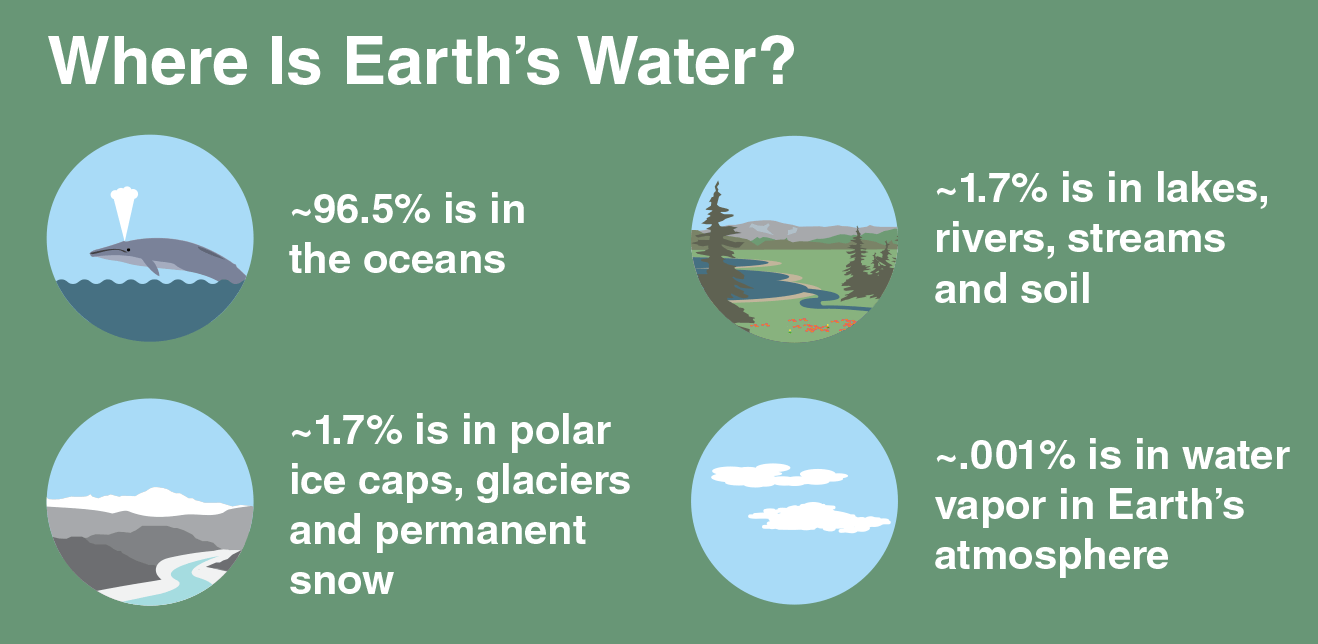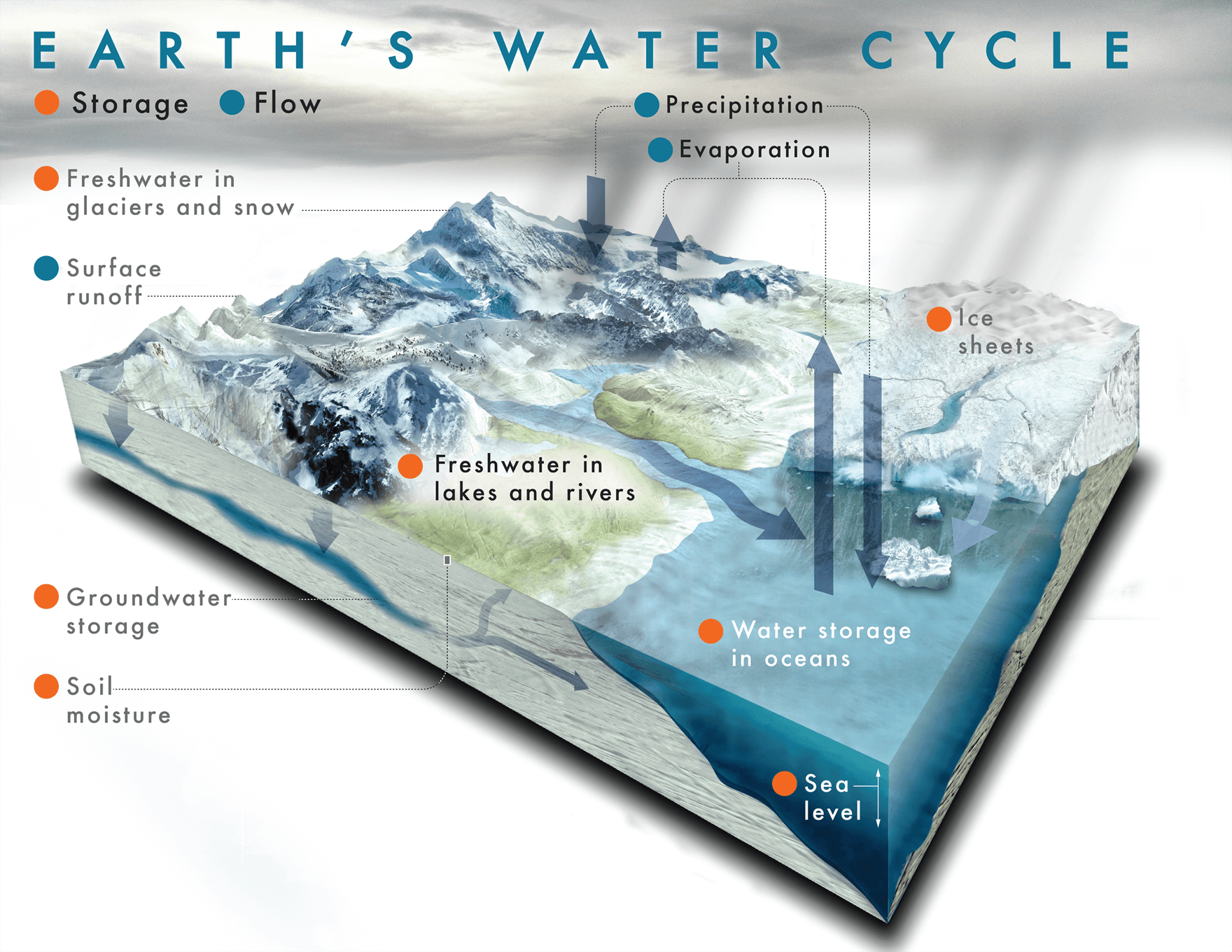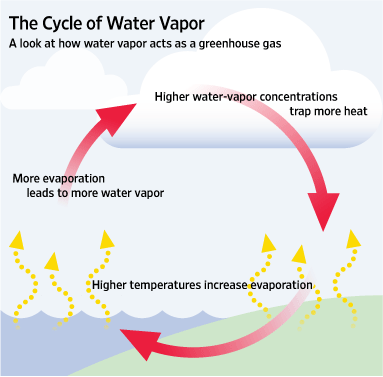AIM: TO LOOK AT THE WATER CYCLE AND HOW CLIMATE CHANGE IS AFFECTING IT.
Definition:
In the connecting of the different parts of the water cycle; we first started precipitation as our main base. Our group then progress on talking about what connects to it; for that, we took and connected it to condensation. One reason we connected it is that if the condensation may be enough, precipitation would be very much possible. An example of this event would be the condensation of clouds and precipitation would be the rain that it process; as well as condensation of different liquids as well. Connecting to it we found evaporation, which the vaporization that occurs on the surface of a liquid. We knew that by evaporation, condensation will occur, then while in this subject water vapour will occur and is very much related to evaporation. These water vapour and evaporation occur because of the large bodies of water that we have which as the likes of freshwater and the oceans; which are part of the Hexagons that we have done as well. The nest part of this is carbon dioxide, which seems quite unrelated, though it is very much so. The burning of fossil fuels [what we've discussed previously] creates C02 which what we've discussed as well, traps the sunlight from bouncing back to space. Therefore it is heating our planet, global warming which is melting the Arctic and the Antarctic; also is responsible for more evaporation, which then turns to condensation and back to precipitation which is a product of condensation. If more of such things should occur, there will be larger rains which we know relates to climate change, the rains become storms which in time will be hurricanes. Strong hurricanes will soon result in a lot of damage and could in time cause severe flooding. That is what we've connected so far.


Scientific words:
- Evaporation. When water is heated by radiant energy it turns into water vapour.
- Transpiration. Evaporation from plants.
- Condensation. When water vapour cools, molecules join together and form clouds.
- Precipitation. When clouds get heavy the waters falls as rain, sleet, hail, or snow.
- Acidification: the action or process of making or becoming acidic.
We will be conducting an experiment that looks at the different ways that climate change is affecting the water cycle.


THE WATER CYCLE EXPERIMENT
Bag 1: Normal Water cycle
Bag 2: Water cycle with CO2 added: like Oceans in climate change
Bag 3: Water cycle with ice added: like Antarctica in climate change
Bag #1
Material:
- Plastic bags/ziplock bags.
- Vivid Markers.
- Water.
- Food colouring.
Steps:
- Grab your ziplock bag lay it on a hard surface.
- Hold your vivid and draw the water cycle by drawing water, clouds, sun, etc.
- Label your drawing by putting the process, like evaporation, transpiration, etc.
- Insert 1 cup of water in the bag and put 2 drops of food colour in the bag(preferably blue).
- Stick the bag to a location where there is sunlight and observe within several days.
Findings:
The Water Cycle: Bag 1
|
CO2 Water Cycle: Bag 2
Acid
|
Desert Water Cycle
Bag 3
| |
Does it cycle?
| Yes | Yes | Yes |
Amount of Water
| 2 | 2 | 2 |
Acidity
| 1 | 2 | 1 |
Key: Water and acidity amount:
1= none
2 = small drips
3 big drips
Other comments:
1. Bag 1
- The first water cycle experiment had not any amount of acidity.
- The water cycle that we hypothesized has indeed happened.
- There were small drops of evaporated water around the sides of the bag.
2. Bag 2
- There was acidity in the second bag.
- The acidity was in the form of soda water.
- The same cycle happened, evaporation, precipitation, etc.
3. Bag 3
- Bag 3 had the least amount of water and was not as plentiful as the other bags.
- Again the cycle occurred, even though it had less liquid.
- Small drops of water can be seen inside the bag.
Conclusion:
The water cycle is an ever-recurring phenomenon. Each of the steps that it takes is fundamental to the reaction that it does. A location no matter how less liquid it contains if exposed to enough heat it will evaporate. In conclusion, the experiment proved our hypothesis that each of the bags did indeed have their liquids evaporate and turn into small drops of water. All of the bags including bag 3 which represents desert water cycle had omitted moisture.
Draw a labelled diagram of the Water Cycle
Water cycle words:
- Precipitation - Any product that condensation produces.
- Hurricanes - They are a natural disaster which brings heavy rain and strong winds; which occurs around the Atlantic.
- Storms - Storms are a natural phenomenon that can turn into hurricanes when the closed circle becomes an "eye"; it typically brings thunder, rain, lightning and or snow.
- Evaporation - A type of vaporization that occurs on the surface of the liquid.
- Carbon Dioxide - Carbon dioxide or C02 is 1 part carbon and 2 parts oxygen; it is an essential part of photosynthesis, fire extinguishers, etc.
- Water-Water/ H20 is a main part of the earth's streams, rivers, oceans and is fundamental to life forms.
- Oceans - A body of water, a very large expanse of sea, that is divided geographically.
- Water vapour - It is a state of water where it becomes gas, can be produced by evaporating water.
- Freshwater - Freshwater is water that is not fro the sea; examples of these are the likes of rivers, streams, lakes, etc.
- Flooding - It is when commonly dry land is submerged with water.
SOLO Hexagons Activity
Water cycle words:
Water cycle words:
- Precipitation
- Hurricanes
- Storms
- Evaporation
- Carbon Dioxide
- Water
- Oceans
- Water vapour
- Freshwater
- Flooding

TODAY YOU WILL BE INVESTIGATING THE EFFECTS THAT CLIMATE CHANGE HAS ON THE WATER CYCLE.
- Using your SOLO hexagons poster write a paragraph about the different aspects of climate change.
- Write about the following Climate Change concepts:
You can do these by powerpoint, embedding a movie, on your blog, on a doc or any other form of presentation. It is up to you.
ACIDIFICATION: HOW DOES CLIMATE CHANGE CONTRIBUTE TO THE ACIDIFICATION OF OUR OCEANS?
The burning of fossil fuels not only greatly affects climate change; the warming of our globe which causes severe problems for some certain species of animals. As well as the rise of sea levels which threaten islands from being erased from the map; the very unusual weather patterns, making hurricanes more common resulting in flooding. However, that is not the only problems that pose for us. The oceans absorb C02, in fact, it absorbs about 30% of the carbon dioxide in our atmosphere. The ever sustaining absorption of C02 results in an unpleasant chemical reaction that increases the concentration of hydrogen ions. The increase makes the seawater more acidic; hence the production of carbonate ions is significantly less. Given that, carbonate ions are fundamental to the production of seashells and organisms such as coral skeletons; twill is a lot more challenging to maintain such organisms.
Picture:

Diagram of how it affects the water cycle.

DEFORESTATION: HOW DOES DEFORESTATION AFFECT CLIMATE CHANGE?
Deforestation affects climate change; one because trees transform the carbon dioxide in our atmosphere into oxygen. Without the trees that we have now the carbon dioxide in our atmosphere may not lessen to a significant amount. Flooding would be a very likely event that would occur as well; no trees means that there would be less matter to absorb the water from precipitation. Not only that but then transpiration would not pe possible thus not being able to release vapour; that would cause no condensation leading to no precipitation. With no precipitation, the land of which the trees are in would likely be dried; killing the vegetation and would not be a habitable space for trees to thrive.
Picture:

Diagram of how it affects the water cycle.

ICECAP MELT: HOW DOES ICECAP MELT AFFECT CLIMATE CHANGE?
The ice from the Arctic and the Antarctic is melting at a fast rate. This melting would be a reason for the rise of sea levels. This would cause further damage to those who are on the low ground as well as the islands that small. This would not only be a crisis for the people around those lands catastrophic for the animal species around the area as well.Picture:

Diagram of how it affects the water cycle.
WATER VAPOUR: HOW DOES CLIMATE CHANGE CONTRIBUTE TO WATER VAPOUR AND EVAPORATION?
The amount of water vapour that has been evaporating would cause condensation. The condensation would turn into precipitation; meaning more rain, stronger hurricanes and typhoons. This would also result in more unpredictable weather patterns. These strong and longer hurricanes and typhoon would be a reason for floods; then these flood would have devastating effects on our cities and towns. Not only that but these floods could affect habitats around the globe, theoretically, this would result in the extinction of several species.
Picture:

Diagram of how it affects the water cycle.

What are some things that we could do individuals could help solve this global problem?
3 R's -
We reduce the amount of pollution that we make. This could be done such as by minimalizing our carbon footprint; if the destination that you want to travel to could be reached by walking and would not take long. Walk to that location instead of using a fossil-fueled vehicle, this may also be achieved by using a bicycle or any type of vehicle that uses human power or electricity. Another way that you could contribute to solving this problem is by reducing the resources that you use. Try to lessen the quantity of tree made materials that you use. Lower the amount of paper, as well as planting trees; these such things would help us to be one step closer into overcoming this calamity.
Reusing materials such as a reusable bag, cups, straws, plates, etc. Reuse what you can, reuse old material that may be damaged but can still be usable in another way.
Recycle paper, cardboard, etc. You could also buy recycled materials, clothes, decorations and everyday objects that you may need. Environment-friendly materials,
No comments:
Post a Comment
Comments
Please structure your comments as follows:
Positive - Something done well
Thoughtful - A sentence to let us know you actually read/watched or listened to what they had to say
Helpful - Give some ideas for next time or Ask a question you want to know more about